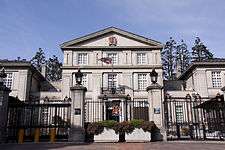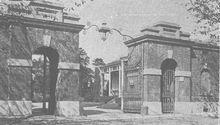British Embassy, Tokyo
| British Embassy, Tokyo 駐日英国大使館 | |
|---|---|
 | |
| Location |
|
| Address | No 1 Ichiban-cho, Chiyoda-ku, Tokyo |
| Coordinates | 35°41′11″N 139°44′40″E / 35.68639°N 139.74444°ECoordinates: 35°41′11″N 139°44′40″E / 35.68639°N 139.74444°E |
| Ambassador | Paul Madden |
| Website | Office Website |
The British Embassy, Tokyo, is the chief diplomatic mission of the United Kingdom in Japan, with the Ambassador of the United Kingdom to Japan being the chief of mission. The embassy compound measures about 35,000 m2, located at No 1 Ichiban-cho, Chiyoda-ku, Tokyo (Japanese: 東京都千代田区一番町一), to the west of the Imperial Palace, and separated from the latter by a moat.
Role
The British embassy performs a sustaining role in Japan–United Kingdom relations, dealing with political, economic and cultural interaction between the two nations, and also offers visa services to Japanese and other nationals in Japan. It provides resources for about 16,000 U.K. citizens in the country, as required.
The U.K. also runs a Consulate-General in Osaka, which reports to the embassy in Tokyo.
History

The United Kingdom established diplomatic relations with the Tokugawa shogunate in 1858. The first British Legation was opened in Tōzen-ji temple, Takanawa, Edo (now Tokyo) in 1859. Meanwhile, Sir Rutherford Alcock, then Consul-General, was promoted to Minister Plenipotentiary.
Owing to attacks in 1861 and 1862, the British Legation was moved to Yokohama. On January 31, 1863, Takasugi Shinsaku led a squad and set fire to the construction site for a new legation building in Gotenyama, Shinagawa, as a part of the Sonnō jōi movement (revere the emperor, expel the barbarians), and the site became unusable.
In view of the inconvenience caused by the distance between Yokohama and the capital, the Minister, Sir Harry Smith Parkes, made use of Sengaku-ji temple in Edo as a temporary office. To find land for the permanent use of the legation, Parkes surveyed several properties abandoned by daimyō as a result of the abolition of the domain system, and he obtained the land required in the fifth month of 1872.[1] The legation at Ichiban-cho, completed in December 1874, was a red-brick building designed by Thomas Waters, also famous for rebuilding Ginza as a Western-style "Bricktown".[2]
After the Japanese victories over China and Russia, which earned the Empire of Japan status as a great power, the British Legation in Tokyo was upgraded to an embassy in 1905. After the 1923 Great Kantō earthquake caused extensive damage to the chancery, plans for a second building were carried out by the Ministry of Works, and a new chancery, the present building, came in use in 1929.
The interruption of diplomatic relations between the British Empire and Imperial Japan occurred at the outbreak of the Pacific War in 1941, and the British Embassy in Tokyo was closed down. Following the Liberation of Japan in 1945, the embassy compound became a shore establishment of the Royal Navy, named HMS Return.[3][4] Between 1946 and 1952, prior to the Treaty of San Francisco, the British Liaison Mission in Tokyo performed the role of a diplomatic mission in Japan. The treaty came into force on April 28, 1952, and the British embassy was re-opened.
Access
The embassy is served by the Hanzōmon Station on Hanzōmon Line, Tokyo Metro.
See also
| Wikimedia Commons has media related to British Embassy, Tokyo. |
References
- ↑ 荻原、pg76。原資料は明治5年3月28日(1872年5月5日)付けの「英国公使館地所証書」
- ↑ The Far East, A Monthly Illustrated Journal, Tokyo, January 31, 1875
- ↑ "Tokyo, Sharks and Ice Cream. ABCtales". Ericv. 2013. Archived from the original on 29 October 2013. Retrieved 23 October 2013.
- ↑ "Hugh Cortazzi - Collected Writings". Cortazzi, Hugh. 2000. Retrieved 23 October 2013.
.svg.png)